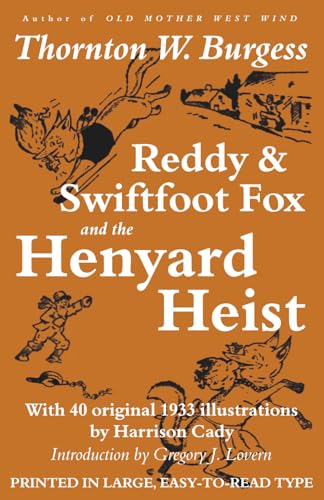The hens were busily hunting for the last scraps of their breakfast. Back of the barn Reddy Fox was moving swiftly. He reached the end and cautiously peeked around it, showing no more than his nose and one eye and ear. The way was clear. No one was in sight. His keen nose brought him no disturbing scent of man or dog.
Reddy & Swiftfoot Fox can’t find enough to eat after an unusually harsh winter storm. Can they steal hens from a farm? They’ll have to brave terrible guns, a smart hound, and cruel traps!
Reddy turned the corner and moved softly, swiftly along the end of the barn keeping close to it and crouching low. Not yet could he see the hens, but he could hear them talking. Once he stopped to listen, his sharp ears cocked forward. Then he moved forward swiftly to the next corner. As he approached this he fairly crept, flattening himself on the snow.
Like many of the families of their young readers, Reddy & Swiftfoot were having a very hard time getting by in 1933, the hardest year of the Great Depression. Follow Reddy & Swiftfoot as they move to greener pastures, raid henyards, and evade hunters and traps. All with fully realistic cleverness from an author who knew very well how real foxes, as well as farmers and hunters, behave.
Slowly, very, very slowly, Reddy poked his nose past the corner until he could see around it. His eyes glistened as he saw those unsuspecting hens. Then he studied the house and took notice of just where the door was. He looked for a dog or signs of one. He tested the air for hint of an enemy. All was peaceful and quiet save for the contented clucking of the hens.
“I’ll wait until one comes a little nearer,” thought he.
Thornton W. Burgess was one of the most popular and loved children’s authors of his time. Generations later, parents and grandparents still enthusiastically introduce his work to young children today.
It isn’t just that his stories are very entertaining. Burgess was also one of the most knowledgeable naturalists of his day, and almost every chapter describes real wild animal behavior. More than any other children’s author before or since, he gives his young readers a genuine sense of what it’s like to live as the wild animals in his stories. His books are as educational as they are enjoyable.
Burgess is best known today for the Bedtime Stories series such as The Adventures of Reddy Fox, as well as his 1910 breakout bestseller Old Mother West Wind. But from 1912 through 1960, Burgess wrote a daily syndicated newspaper column of animal stories for children–15,000 daily episodes in all. Most of his books were derived from those newspaper stories. Daily episodes became chapters in books.
Only about a tenth of those newspaper episodes ever became books. The rest were never published again during his lifetime, and very few since then.
This story about Reddy Fox and his mate Swiftfoot–also known as Mrs. Reddy–was originally syndicated in newspapers in 1933. It was never published again until this volume. The only other way to read this story is to find Burgess’ column in each of the forty-two 1933 newspapers in which it appeared.
The daily episodes had a small illustration by Harrison Cady, well-known for illustrating most of Burgess’ books. 40 of those original illustrations are included here. They are small and simple, meant for printing within a single newspaper column, but they all have Cady’s signature charm.
Though Burgess wrote for children, he was as widely read and loved by adults–even those with no children at home to read his stories to–as he was by children.
After a while one of those hens strayed a little nearer. Reddy set his feet for a quick rush.
But then the door of the house opened and the farmer stepped out.
If you have enjoyed Thornton W. Burgess’ other wonderful children’s stories, you’ll love this one too!









Reviews
There are no reviews yet.